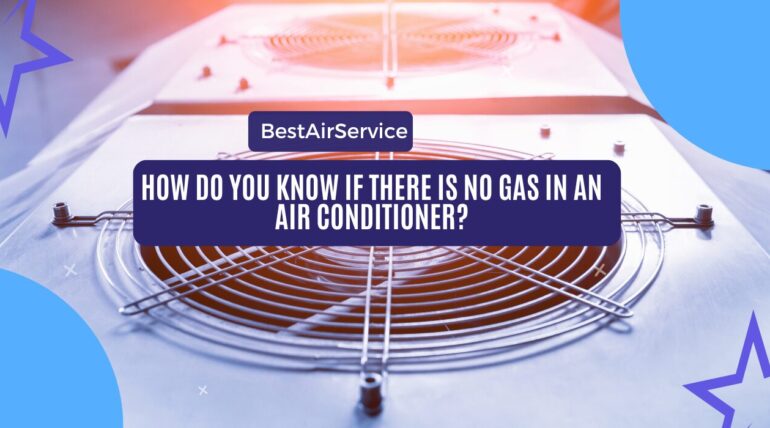
September 24, 2024
Do you know that your air conditioner doesn’t actually create cold air rather, it uses colder air to replace the heat your house generates. This procedure depends on a key component—refrigerant gas—to maintain uninterrupted operation. Your AC cannot efficiently cool your room without the proper level of this gas, hence warm air results. This is a highly needed cold relief. But how would you find out your air conditioner runs without gas? Let us examine some of the indicators and their implications for your cooling system.
What Does the Refrigerant Gas Do in Your Air Conditioner?
Let us first define refrigerant gas and explain why it is so important before delving into the low refrigerant symptoms. The refrigerant is a chemical molecule that circulates through your AC system absorbing heat from within your house and releasing it outside. Your AC’s lifeblood is basically its ability to efficiently cool the air; without it, your system can’t perform so.
Importance of Proper Refrigerant Levels
For many different reasons, proper refrigerant levels are necessary. First, your air conditioner won’t be able to chill your house as effectively as it could if it isn’t running at full efficiency. This implies that you might be paying more than required on your utility bills and that, if you drive the unit too hard without appropriate maintenance, over time you could potentially destroy it.
Second, if not discovered early enough, poor refrigerant levels can result in expensive repairs down-road or, worse yet, cause irreversible damage requiring replacement of parts or perhaps a complete system entirely (which would cost thousands). Ultimately and most importantly: improper refrigerant levels can have major effects on the surroundings! Make sure yours is correctly maintained since poorly kept air conditioners emit greenhouse gases into the atmosphere that greatly contribute to global warming!
Types of Refrigerants:
Refrigerants come in three basic varieties:
- R-22 (Freon): Commonly utilized in older systems, R-22 (Freon) is being phased out for damage to the ozone layer.
- R410A (Puron): Designed as a green substitute for R22, Puron (R410A) has a smaller global warming potential. Still, it includes several HFCs that, in improper control, could worsen climate change.
- R32: Comparatively to R-22 and R-410A, R32 is the most environmentally benign choice having a far lower global warming potential. Many air conditioning systems use it since it is quite efficient, and lowers energy consumption and costs.
Refrigerant is not “used up” in your air conditioner the way a car consumes gasoline. Rather, it moves inside a closed system. Therefore, typically speaking, a low AC on refrigerant indicates a leak in the system. How then can you find out whether your air conditioner is running low or out of gas? Let’s cover some of the common indicators.
Low Refrigerant Symptoms in Air Conditioner:
It can take more than one visit to find and repair refrigerant leaks unless your leak is big with an audible hiss. Pinhole leaks can be difficult to find; hence, sometimes dye is employed in diagnosis. Extremely high temperatures can also cause leaks and blow out welded-together pipes. Since the evaporator coil indoors experiences the most volatile temperature variations, most typically this occurs there.
Finding low refrigerant symptoms can be challenging until everything has simply ceased working completely. Sometimes you can discover it early and stop a more costly repair if you observe the temperature and humidity interior gradually rising little by bit. Here are some low refrigerant symptoms in air conditioners:
Takes a Long Time to Cool
If your space takes more time to cool off, it could point to refrigerant-related issues. Your indoor thermostat might be inching up in temperature and humidity for no clear explanation. Another traditional complaint is if your air conditioner catches up in the evening but does not cool well throughout the day.
Not Blowing Cool Enough Indoor Air
What temperature is it if you hold your palm up to your air vents blowing conditioned air? Sometimes a refrigerant issue is indicated if it seems considerably warmer than it should. Remember that it might not blow as cool in a 100-degree outdoor temperature.
Copper Lines: Frost or Ice
Unbalanced refrigerant levels might cause the refrigerant to get overly cold and limit ventilation. Restricted airflow strains your air conditioner greatly and may freeze your evaporator coil, so stopping it from working. A frozen indoor coil might also result from other poor airflow factors, including filthy air filters.
Water Gathering Around the Furnace
Your air conditioner will finally defrost out and the residual condensation will start to leak if it has been frozen. Sometimes a problem with refrigerant might be indicated by the obvious indicators of water pooling around the inside furnace.
Listen for bubbling or hissing noise
Sometimes the interior evaporator coil or outdoor condensing unit produces a hissing or bubbling noise if your leak is really large. In this instance, the temperature within your house could rise rapidly and turn uncomfortable.
Every now and then we find an air conditioner totally empty of refrigerant due to what we refer to as “blown points.” Another name for a compressor failure is a All of your refrigerant supply will be wasted should an electrical failure force the compressor of your air conditioner to explode. Along the bottom of the outdoor condenser, the outdoor unit will vent the remaining refrigerant and oil. If you are in the correct spot at the correct moment, you will hear a strong hiss and see a white cloud. Keep your distance since being around can be really deadly. We advise seeking a professional evaluation of the matter.
Short Cycling
Your air conditioner can develop a frustrating pattern known as “short cycling” when it tries to cool but cannot. An air conditioner that turns on and runs briefly then turns off is said to be short cycling. Your air conditioner never fully runs through a real cooling cycle, then. If you live in an exceptionally humid area like the UAE, humidity levels in your house could rise during this period. Longer running times of an air conditioner cause it to start to seem considerably cooler indoors since it removes much of the humidity when it starts up. On the other hand, if your air conditioner is cycling on and off, it will find it difficult to eliminate sufficient humidity to feel chilly indoors.
Higher Electricity Bills
Higher than average for the time of year electric prices could point to refrigerant issues. Usually, the first sign we check is not a larger electric bill. Naturally, electric bills in a very hot summer will result in more energy expenses. That does not imply a refrigerant issue as such. Higher utility bills do, however, usually accompany an unwell unit trying to cool without enough refrigerant to make it operate as it should. Running far longer than it would typically, an air conditioner without sufficient refrigerant would keep running as it tries to chill the space.
How to Check for Refrigerant Issues
Understanding the indicators of low or nonexistent gas in an air conditioner invites the next question: What should you do about it? Although these indications are obvious, a skilled HVAC technician is more suited to identify and address refrigerant problems.If you believe your AC is low on refrigerant, here is what to do:
- Turn Off Your Air Conditioner: If you see ice build-up or your air conditioner isn’t cooling, turn off the system to stop additional damage.
- Consult a professional: Environmental rules call for particular tools and certification in refrigerant handling. Examining your system, a certified HVAC specialist like BestAirServices will locate any leaks and, if needed, recharge the refrigerant.
- Fix the Leak: Simple adding more refrigerant won’t solve the leak. Locating and fixing the leak will help to guarantee that the system doesn’t lose gas another time.
Regular Maintenance: Frequent maintenance of your AC will help to guarantee that your system is working effectively and help to avoid refrigerant leaks.
Conclusion
In the end, maintaining a cool and comfortable environment depends ultimately on your air conditioner’s low or nonexistent refrigerant gas being identified. From longer cooling times and more energy costs to frost on the copper lines, these signs indicate a possible refrigerant problem. If you have any of these symptoms, it is always advisable to see a professional like BestAirServices instead of attempting self-fixing. As a trained HVAC specialist we can identify the issue, mend any leaks, and bring your AC back to complete functionality. Frequent maintenance and timely inspections by us help avoid such problems, thereby guaranteeing that your air conditioner performs as it should. Stay cool, and don’t let a small refrigerant problem ruin your comfort!


